Key takeaways:
- Mangrove ecosystems are vital for local and global health, offering protection against storms, supporting biodiversity, and acting as significant carbon sinks.
- Threats to mangroves include deforestation, pollution, and climate change, emphasizing the need for immediate conservation efforts.
- Community involvement and sustainable practices are crucial for effective mangrove protection, fostering a strong connection between locals and their environment.
- Education and advocacy play a key role in promoting awareness and driving legislative change for the preservation of mangrove ecosystems.
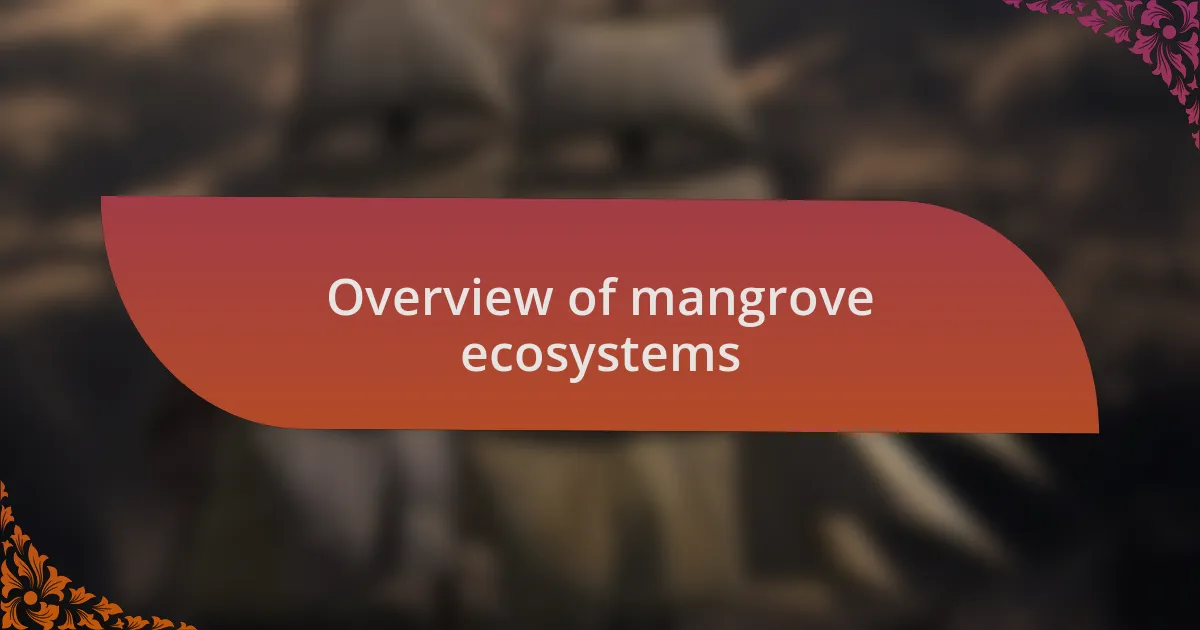
Overview of mangrove ecosystems
Mangrove ecosystems are unique coastal environments characterized by salt-tolerant trees that thrive in intertidal zones. I remember my first visit to a mangrove forest; the air was thick with humidity, and I was instantly struck by the vibrant biodiversity. Seeing crabs scuttle along the roots, while birds flitted above, made me realize just how vital these ecosystems are.
These forests play a critical role in both the local and global environment. They serve as natural barriers against storms and coastal erosion, protecting inland areas from damage. Have you ever considered how a single mangrove tree can absorb several tons of carbon dioxide over its lifetime? This vast potential for carbon sequestration highlights their importance in combating climate change.
In addition to their environmental benefits, mangroves also support local communities through fishing and tourism. I still can picture the friendly fishermen I met during my visit, who spoke passionately about how these ecosystems provide their livelihoods. Their stories illustrated something profound: the connection between human well-being and the health of mangrove habitats is undeniably strong.
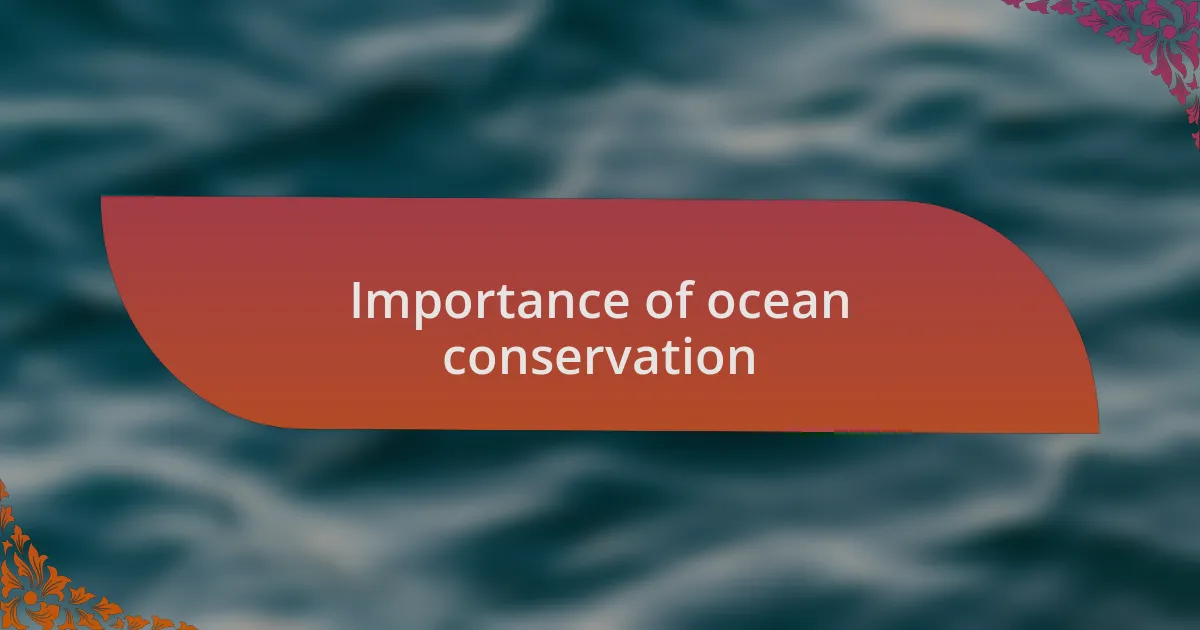
Importance of ocean conservation
Ocean conservation is not just essential for preserving marine life; it also plays a pivotal role in mitigating climate change. I vividly recall standing on a beach, watching waves crash against the shoreline, realizing that the health of our oceans directly influences weather patterns and global temperatures. Have you considered how the ocean absorbs a significant portion of the carbon dioxide we emit? Protecting these vast waters is crucial for maintaining environmental balance.
In my experience, the ocean is a treasure trove of resources that humans depend on, from food to medicine. During a snorkeling trip, I was amazed by the array of marine life—each colorful fish and intricate coral reef contributing to a rich tapestry of biodiversity. As I swam among them, I couldn’t help but wonder how many species are endangered due to pollution and overfishing. This revelation underscored the urgency to prioritize ocean conservation for the well-being of future generations.
Moreover, oceans serve as the heartbeat of our planet, regulating temperatures and containing ecosystems that support millions. When I think back to a coastal cleanup I participated in, I felt an overwhelming sense of camaraderie with fellow volunteers, united by a shared purpose. It struck me that every small action contributes to a larger movement, reinforcing that nurturing our oceans is vital for sustaining all life on Earth.
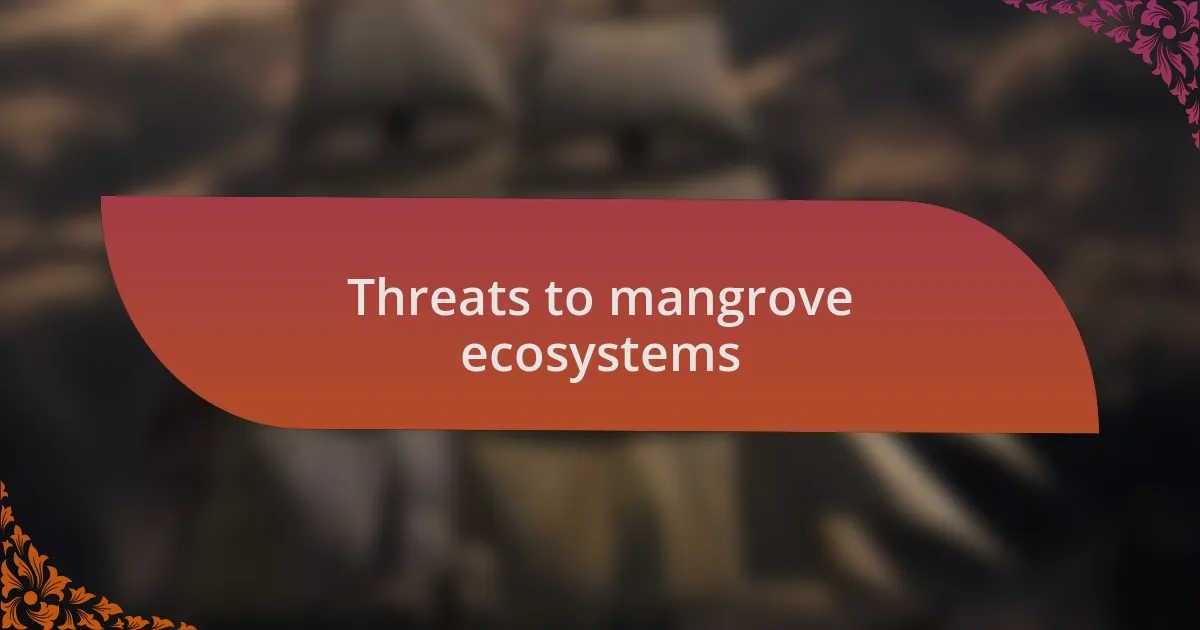
Threats to mangrove ecosystems
The threats to mangrove ecosystems are alarming and often go unnoticed. Deforestation, driven by coastal development and agriculture, strips these vital areas of their protective mangrove trees. I still remember my visit to a coastal region where a once-thriving mangrove forest had been replaced by a sprawling resort—what a loss, not just for the habitat, but for the community that relied on it.
Pollution is another insidious threat. As I walked along the shore, I was struck by the sight of discarded plastics tangled among the roots of mangrove trees. It made me wonder, how can we continue to ignore the detrimental impacts of our waste? Toxic runoff from pesticides and fertilizers further degrades water quality, putting the entire ecosystem at risk.
Climate change poses a grave danger as well, with rising sea levels threatening to inundate mangrove habitats. During a recent workshop, I learned just how sensitive these ecosystems are to changes in salinity and temperature. It was a wake-up call for me—mangroves are not just simple trees by the water; they are complex ecosystems that need our protection now more than ever.
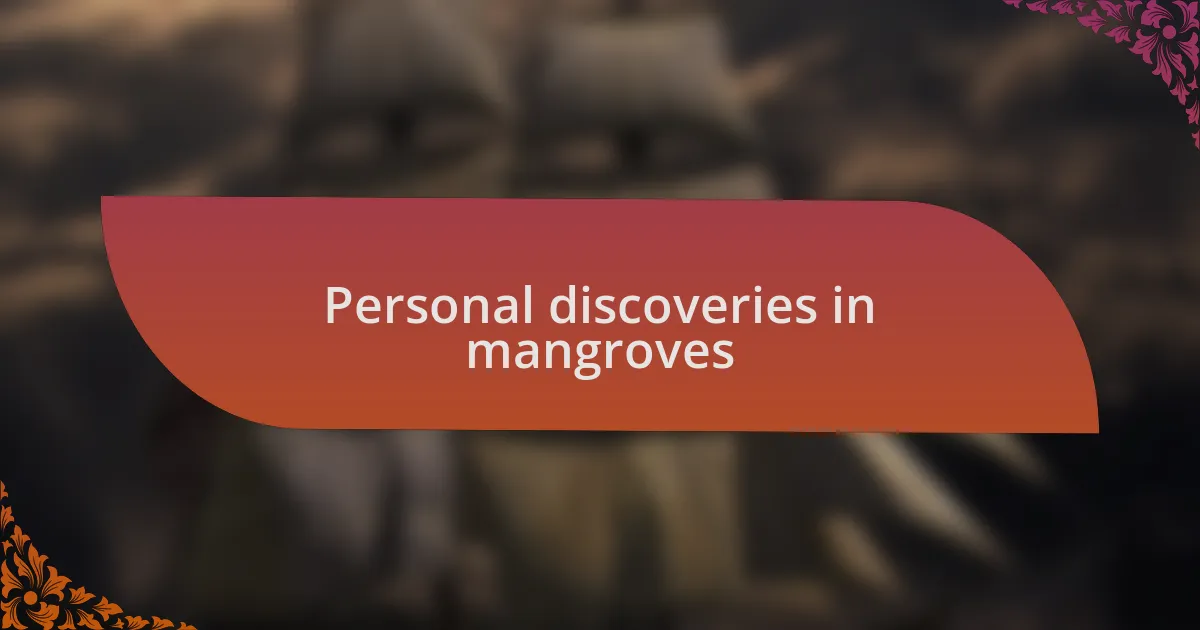
Personal discoveries in mangroves
As I waded through the shallow waters of a mangrove estuary, the rhythmic whispers of the tide were enchanting. It struck me how the intricate root systems of the mangroves play a vital role in stabilizing the shoreline. I felt a sense of awe, realizing this was not just a habitat for many species, but a natural fortress defending the coast against erosion.
On another outing, the vibrant colors of the birds flitting among the branches caught my eye. I remember standing there, captivated by the sight of a kingfisher diving to catch a fish. This moment made me reflect on the interconnectedness of life in these ecosystems; every creature plays a role in maintaining the delicate balance. How often do we overlook the simple wonders happening right in front of us?
One evening, as the sun set over the mangroves, painting the sky in hues of orange and pink, I felt a profound connection to nature. The sounds of the snapping shrimp and the rustle of leaves reminded me that these ecosystems are living entities, thriving despite the challenges they face. It brought to mind a pressing question: if we protect these places, what other secrets might they reveal to us?
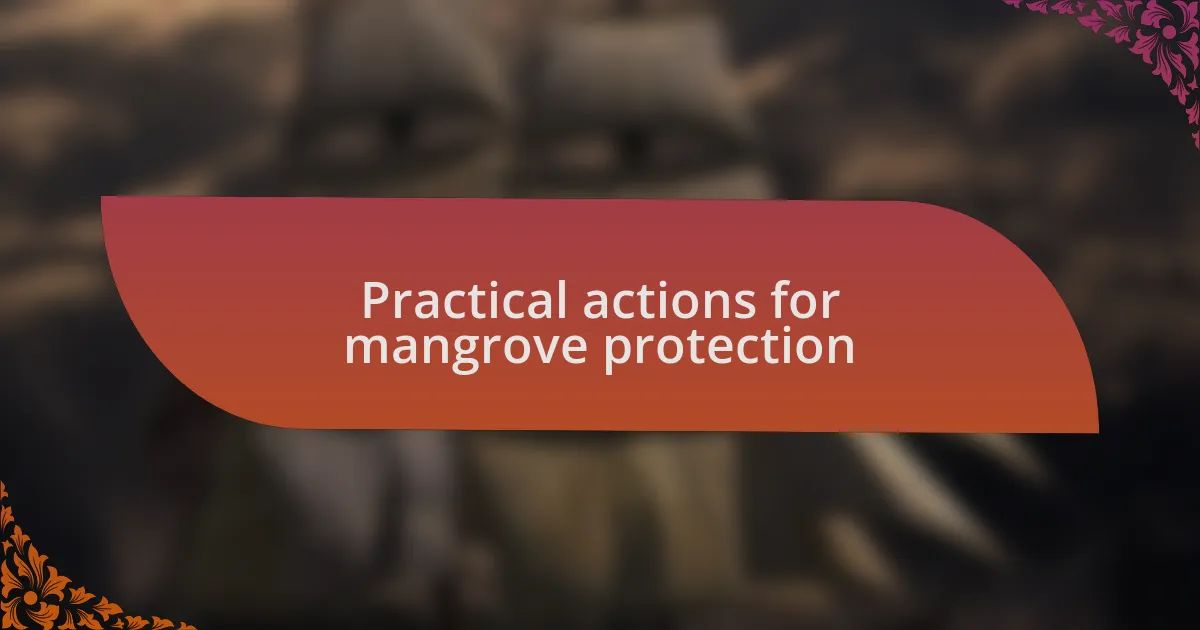
Practical actions for mangrove protection
One effective way to protect mangroves is through community involvement in restoration projects. I remember joining a local group that organized a mangrove planting day. It was heartwarming to see families come together, with children eager to dig and plant. How often do we feel that community spirit? That day reminded me of the incredible power of collective action and the tangible difference we can make when we unite for a cause.
Another practical action lies in advocating for sustainable tourism practices. During my visits, I’ve seen both the beauty and the strain tourism can bring to these ecosystems. I once had a conversation with a boat tour operator who emphasized the importance of guiding visitors through mangroves without disturbing the wildlife. It made me realize that educating travelers about respectful engagement can protect the habitats we cherish while still sharing their wonders.
Moreover, pushing for policy changes at local and national levels can significantly bolster mangrove protection. Reflecting on my experiences, I’ve felt a mixture of hope and frustration when observing the slow pace of legislation. It sparked a thought: if we each make our voices heard, can we not inspire leaders to take decisive action? Together, we have the potential to create a robust framework that values and preserves these essential ecosystems for generations to come.
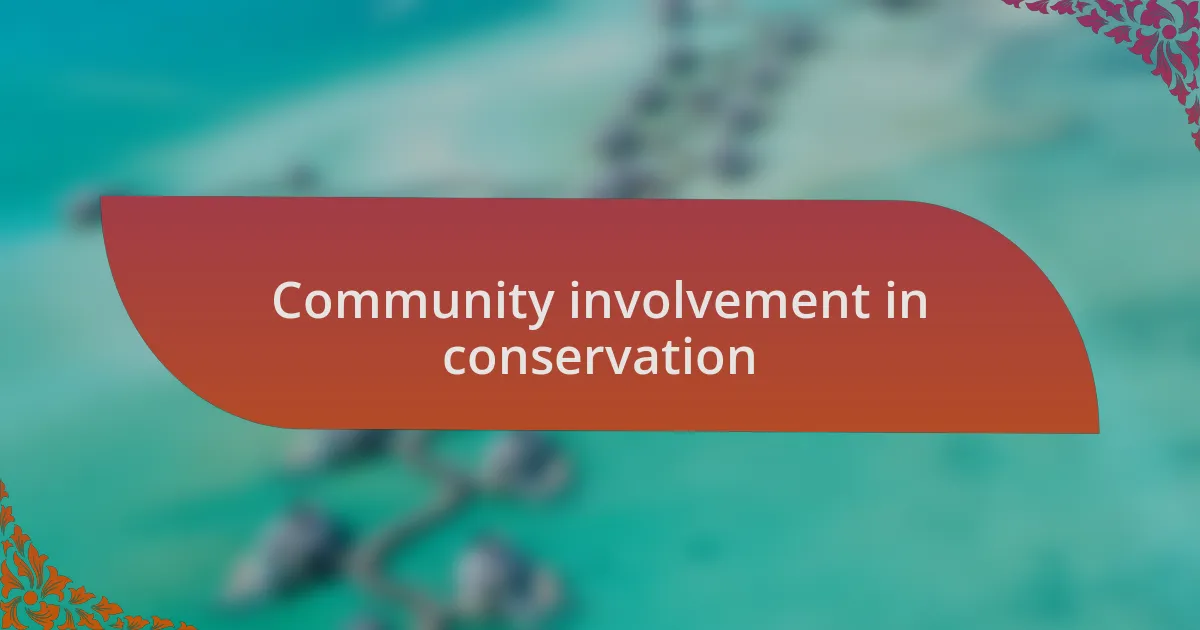
Community involvement in conservation
When communities take an active role in conservation, the results can be transformative. I recall a weekend spent in a coastal village where the locals organized informational workshops on mangrove ecosystems. The passion in their voices, as they shared personal stories of how mangroves protected their homes from storms, made me realize the depth of their connection to the land. Have you ever felt that kind of bond with a place? It’s inspiring to see how knowledge and shared purpose can motivate people to protect their natural surroundings.
Participatory conservation can also foster a sense of ownership among locals. I witnessed this firsthand when a group of fishermen became involved in monitoring fish populations in mangrove areas. Their keen observations not only helped in sustainable management practices but also empowered them to advocate for their ecosystems. It struck me: when people feel they have a stake in conservation efforts, they’re more likely to see the value of maintaining these delicate habitats.
On the other hand, I’ve seen community outreach programs that turned into beautiful partnerships. I remember attending a beach clean-up where local schools collaborated with environmental organizations. The chatter of excited children mingled with the sound of waves, illustrating a shared commitment to keeping the ocean and its fringes clean. Isn’t it remarkable how initiatives like these can plant seeds of awareness in younger generations? Involving the community isn’t just about action; it’s about cultivating a legacy of stewardship that integrates environmental health into local culture.